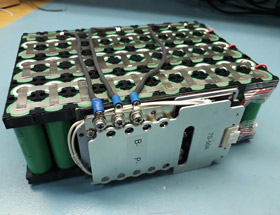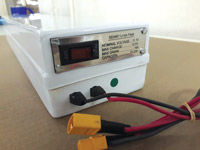

The main consideration and guide to battery pack design is the power requirement and supply duration. There are mainly three types of power requirements:
• High capacity with a low discharge rate: One typical application is street lights, where the battery must last a long time, usually more than eight hours. Assembly of the packs will be as per customer requirement but normally packed in a small configuration with cells close together to minimise the size.
• High capacity with a high discharge rate: This includes applications such as e-bikes and other motor-driven applications. Another application would be for use in sustainable energy during load shedding, where high power is required for a short period of time until the power is restored. Assembling the packs using spacers will be used to separate the cells to prevent excess heat build-up on the connected cells.
• Low capacity with a high discharge rate: These types are used in applications such as UPS (uninterruptible power supply) systems, mainly for computers and data centres, allowing a short time of 15 to 20 minutes to save information.
Chemistry is important
Recently lithium iron phosphate (LiFePO4) has been becoming the ‘best choice’ of materials in commercial Li-ion (and polymer) batteries for large capacity and high-power applications, such as laptops, data centres, avionics, power tools, wheel chairs, e-bikes, e-cars and e-buses. Considerations have to be weighed up when doing this: the energy density of Li-ion is higher than that of LiFePO, but LiFePO4is much safer and has a voltage range that makes it a direct replacement for lead acid batteries.
Because of the low reliability, mainly with respect to the cycle life, of lead acid batteries, we have noted the trend to use LiFePO4 batteries rather than lead acid batteries and therefore replacing lead acid in solar storage and other applications.

In addition, lithium iron phosphate batteries are among the longest-lived batteries ever developed. Test data in the laboratory show up to 2000 charge/discharge cycles. This is due to the extremely robust crystal structure of the iron phosphate, which does not break down under repeated packing and unpacking of the lithium ions during charging and discharging.
Most lead acid batteries should only be charged at 10% of their rated capacity and that can take long periods of time. LiFePO4batteries, on the other hand, can be charged at 50% of their rated capacity, making it possible to recharge the battery fully in a short period of time. During a high rate of use, partial state charging can be performed with LiFePO4 batteries when required, whereas with lead acid scheduled charging needs to be performed.
The initial cost of LiFePO4 batteries is more expensive, but the cycle life makes it worth the cost. LiFePO<4 has an energy density of approximately 14 W/100 g whilst lead acid only has approximately 5 W/100 g.
A major limitation of lead acid batteries is that it is possible to severely damage the battery in a single charge or discharge cycle. This is prevented in lithium based batteries due to the protection circuitry added to the battery pack. This circuitry is known as a PCM (protection circuit module) or a BMS (battery management system) for the more expensive solutions where the user would like to communicate with the device to retrieve voltages, current and temperatures.
This device prevents over-charging, over-discharging, and balances the cells in the battery pack, prolonging the life and keeping the battery safe. This ensures that all the cells are always at the optimum voltage for maximum efficiency.
Just Batteries is a proudly South African company that provides customised energy solutions with a highly skilled engineering team that performs custom designs and development of all battery pack requirements to customers across Africa. Its expertise extends to all major chemical systems, with products exported around the world.
It has agencies with several reputable suppliers in the battery industry, and combined with a highly skilled engineering team, it offers battery pack design and assembly to create specialised products and services for its customers.
Some of these brands are Brentronics, Energizer, Panasonic, Tadiran, GS Yuasa and SAFT batteries.
Just Batteries’ reputation for high-quality products led to its appointment as the sole distributor for SAFT Batteries’ portable division. The company is also authorised to carry out all technical requirements on the SAFT products that it represents.
Just Batteries has also been appointed by Energizer as a duly authorised manufacturer of industrial battery packs comprising of Energizer products, and to carry out distribution of Energizer batteries in industrial applications.
| Tel: | +27 11 023 8846 |
| Email: | [email protected] |
| www: | www.potensa.co.za |
| Articles: | More information and articles about Potensa |

© Technews Publishing (Pty) Ltd | All Rights Reserved